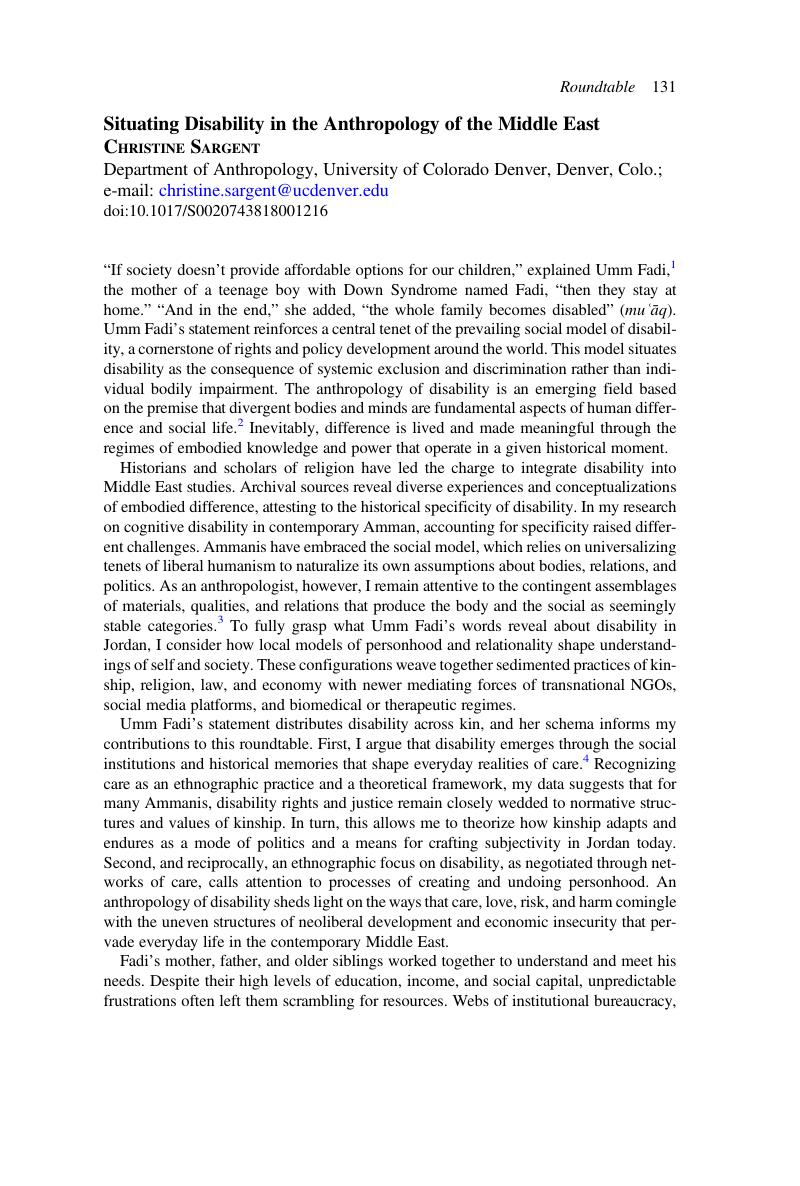No CrossRef data available.
Published online by Cambridge University Press: 14 January 2019

Author's note: Many thanks to the families and individuals who made my project possible, and to the generous colleagues—Geoffrey Hughes, Nama Khalil, Susan MacDougall, Ana Vinea, Rayya El Zein, and Tyler Zoanni—who helped me think through this piece.
1 These pseudonyms employ the kunyeh formula commonly used by my interlocutors.
2 Ginsburg, Faye and Rapp, Rayna, “Disability Worlds,” Annual Review of Anthropology 42 (2013): 53–68CrossRefGoogle Scholar; Kasnitz, Devva and Shuttlesworth, Russell, “Introduction: Anthropology in Disability Studies,” Disability Studies Quarterly 21 (2001): 2–17CrossRefGoogle Scholar.
3 This point builds on Elizabeth Roberts’ critical approach to biosociality in Ecuador. See Roberts, , “Biology, Sociality and Reproductive Modernity in Ecuadorian In-Vitro Fertilization: The Particulars of Place,” in Biosocialities, Genetics and the Social Sciences: <aking Biologies and Identities, ed. Gibbon, Sahra and Novas, Carlos (New York: Routledge, 2008)Google Scholar.
4 I draw here from critical, feminist, and anthropological perspectives on care. For an overview, see Buch, Alana, “Anthropology of Aging and Care,” Annual Review of Anthropology 44 (2015): 77–93CrossRefGoogle Scholar.
5 Mayssoun Sukarieh analyzes these dynamics in “The Hope Crusades: Culturalism and Reform in the Arab World,” Political and Legal Anthropology Review 35 (2012): 115–34CrossRefGoogle Scholar.
6 See Adely, Fida, Gendered Paradoxes: Educating Jordanian Women in Nation, Faith, and Progress (Chicago: University of Chiago Press, 2012)CrossRefGoogle Scholar; and Hasso, Frances H., “Empowering Governmentalities Rather than Women: The Arab Human Development Report 2005 and Western Development Logics,” International Journal of Middle East Studies 41 (2009): 63–82CrossRefGoogle Scholar.
7 Jordan's disability activists partake in transnational human rights campaigns and development projects. They are conversant in international and domestic disability law and work to close the gaps between law and practice. Many activists have bodily impairments and are employed by the government, Disabled Persons Organizations (DPOs), or NGOs. Most of my interlocutors, however, did not belong to these networks, identifying as concerned parents and caregivers.
8 Hasso, Frances H., Consuming Desires: Family Crisis and the State in the Middle East (Stanford, Calif.: Stanford University Press, 2011)Google Scholar; Hughes, Geoffrey, “Infrastructures of Legitimacy: The Political Lives of Marriage Contracts in Jordan,” American Ethnologist 42 (2015): 279–94CrossRefGoogle Scholar.
9 Two recent examples are Inhorn, Marcia C. and Tremayne, Soraya, “Islam, Assisted Reproduction, and the Bioethical Aftermath,” Journal of Religion and Health 55 (2016): 422–30CrossRefGoogle ScholarPubMed; and Samin, Nadav, Of Sand or Soil: Genealogy and Tribal Belonging in Saudi Arabia (Princeton, N.J.: Princeton University Press, 2015)Google Scholar.
10 Hall., Kim Q. “New Conversations in Feminist Disability Studies: Feminism, Philosophy, and Borders,” Hypatia 30 (2015): 1–12CrossRefGoogle Scholar.
11 See Friedner, Michele, Valuing Deaf Worlds in Urban India (New Brunswick, N.J.: Rutgers University Press, 2015)Google Scholar on deafness in urban India, Nakamura, Karen, A Disability of the Soul: An Ethnography of Schizophrenia and Mental Illness in Contemporary Japan (Ithaca, N.Y.: Cornell University Press, 2013)Google Scholar on mental illness in Japan, and McKearney, Patrick and Zoanni, Tyler, “Introduction: For an Anthropology of Cognitive Disability,” The Cambridge Journal of Anthropology 36 (2018): 1–21CrossRefGoogle Scholar.